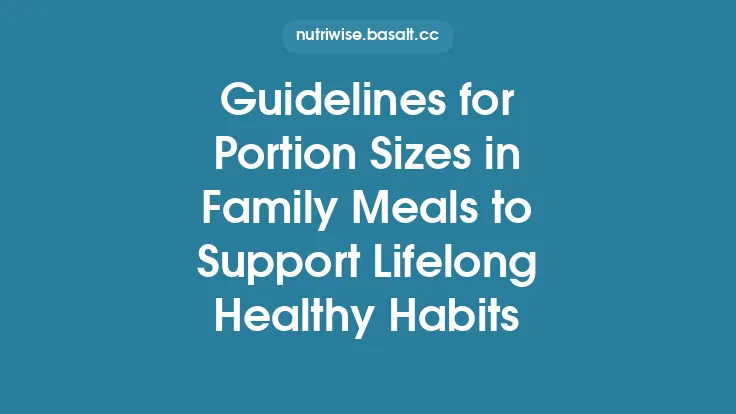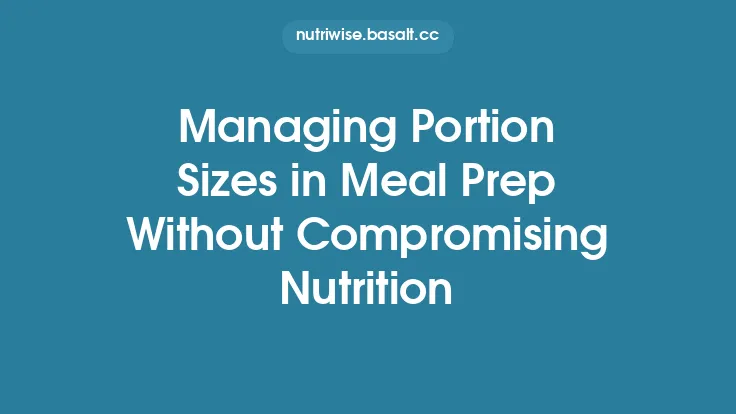Portion sizes sit at the intersection of nutrition science, physiology, and everyday food preparation. While the concept of “how much to eat” may seem straightforward, the underlying mechanisms that determine satiety, nutrient adequacy, and long‑term health are anything but simple. This guide unpacks the scientific principles that govern portion sizing and translates them into practical, evergreen strategies for building balanced meals—without relying on visual tricks, weight‑loss fads, or diet‑specific rules.
The Physiology of Portion Perception
When a bite of food lands on the tongue, a cascade of sensory signals begins. Taste receptors detect sweetness, bitterness, umami, and other qualities, while mechanoreceptors in the oral cavity gauge texture and volume. These signals travel to the gustatory cortex, where the brain starts forming an expectation of how much food will be consumed.
Two physiological systems then take over:
- Gastric Stretch Receptors – As the stomach expands, stretch receptors send afferent signals via the vagus nerve to the hypothalamus. The degree of stretch correlates with the volume of food, providing an early satiety cue that can curb further intake before the nutrients are even absorbed.
- Hormonal Satiety Signals – Within minutes of eating, enteroendocrine cells in the small intestine release hormones such as cholecystokinin (CCK), glucagon‑like peptide‑1 (GLP‑1), and peptide YY (PYY). These hormones act on the brainstem and hypothalamus to reinforce the feeling of fullness. Their release is proportional to the macronutrient composition and the rate at which nutrients appear in the bloodstream.
Understanding that portion size is not merely a visual judgment but a biologically mediated process helps explain why overly large portions can override satiety signals, leading to chronic over‑consumption.
Energy Density and Its Role in Portion Planning
Energy density (kcal per gram) is a cornerstone concept for constructing portions that satisfy hunger without excess calories. Foods with low energy density—such as most vegetables, fruits, broth‑based soups, and legumes—contain a high proportion of water and fiber, allowing larger volumes to be consumed with relatively few calories. Conversely, high‑energy‑dense foods—like nuts, oils, and processed snacks—pack many calories into a small mass.
Practical implications:
| Energy‑Density Category | Typical kcal/100 g | Portion‑Size Strategy |
|---|---|---|
| Low (≤ 0.5 kcal/g) | 20–50 | Use generous volumes (e.g., 200 g of leafy greens) to promote fullness. |
| Moderate (0.5–1.5 kcal/g) | 50–150 | Balance volume with nutrient density; a 150 g serving of whole‑grain pasta fits well. |
| High (> 1.5 kcal/g) | >150 | Limit to smaller, nutrient‑dense portions (e.g., 30 g of nuts). |
By deliberately pairing low‑energy‑dense foods with moderate‑ or high‑energy‑dense components, a meal can achieve a satisfying volume while delivering the necessary macro‑ and micronutrients.
Macronutrient Balance Within a Portion
A balanced meal typically distributes its calories across the three macronutrients in ratios that support metabolic health, muscle maintenance, and sustained energy. While individual needs vary, the following framework is widely supported by the Institute of Medicine and the Dietary Guidelines for Americans:
| Macronutrient | % of Total Calories | g per 2,000 kcal Meal (≈ 600 kcal) |
|---|---|---|
| Protein | 15–25 % | 22–38 g (≈ 4 kcal/g) |
| Carbohydrate | 45–65 % | 68–98 g (≈ 4 kcal/g) |
| Fat | 20–35 % | 13–23 g (≈ 9 kcal/g) |
Applying the ratios to a single portion:
- Determine the caloric target for the meal. For a typical three‑meal day, a 600‑kcal lunch is a common benchmark.
- Calculate gram targets using the percentages above. For a 600‑kcal lunch aiming for a 20 % protein, 55 % carbohydrate, and 25 % fat split:
- Protein: 120 kcal → 30 g
- Carbohydrate: 330 kcal → 83 g
- Fat: 150 kcal → 17 g
- Select foods that meet these gram targets while also providing micronutrients. For example:
- 120 g grilled chicken breast (≈ 30 g protein)
- 150 g cooked quinoa (≈ 30 g carbohydrate, 5 g protein, 2 g fat)
- 100 g roasted broccoli (≈ 7 g carbohydrate, 3 g protein)
- 10 g olive oil drizzled on vegetables (≈ 9 g fat)
By anchoring portion decisions to macro‑gram targets rather than vague “half‑plate” rules, meals become reproducible and nutritionally coherent.
Calculating Portion Sizes From Nutrition Information
Nutrition labels provide the most reliable quantitative data for portion control. The key steps are:
- Identify the “serving size” listed on the label (e.g., 1 cup = 150 g). This is the baseline for all nutrient values.
- Determine the desired caloric or macronutrient amount for your meal. Suppose you need 200 kcal from a canned bean product.
- Use proportional scaling:
\[
\text{Desired portion (g)} = \frac{\text{Target calories}}{\text{Calories per serving (kcal)}} \times \text{Serving size (g)}
\]
If the label states 120 kcal per ½ cup (125 g), then:
\[
\text{Portion} = \frac{200}{120} \times 125 g \approx 208 g
\]
- Adjust macro distribution if needed. The same label will list grams of protein, carbohydrate, and fat per serving; multiply each by the same scaling factor (200/120) to obtain the macro content of the 208 g portion.
When multiple ingredients are combined, calculate each component separately, then sum the totals. Spreadsheet tools or simple calculator apps can automate this process, ensuring precision without the need for a kitchen scale.
Portion Size Scaling for Different Meal Contexts
Not all meals are created equal. Breakfast, lunch, dinner, and snacks each serve distinct physiological roles, influencing optimal portion sizes.
| Meal | Typical Caloric Range (2,000 kcal diet) | Rationale |
|---|---|---|
| Breakfast | 300–400 kcal | Replenishes glycogen after overnight fast; supports cognitive performance. |
| Lunch | 500–600 kcal | Provides sustained energy for afternoon activities; often the largest meal. |
| Dinner | 400–500 kcal | Allows for a lighter end to the day, supporting nocturnal metabolic processes. |
| Snacks | 100–200 kcal each (1–2 per day) | Prevents excessive hunger between meals without displacing main meals. |
Within each meal, the macro ratios can be subtly shifted. For example, a slightly higher carbohydrate proportion at breakfast (≈ 60 % of calories) can aid glycogen restoration, while a modestly higher protein proportion at dinner (≈ 25 % of calories) supports overnight muscle repair. Adjusting portion sizes according to these temporal patterns helps align nutrient delivery with the body’s metabolic rhythms.
Integrating Portion Control Into Meal Prep and Recipe Development
When meals are prepared in advance, portion control becomes a matter of design rather than on‑the‑fly estimation. Follow these systematic steps:
- Define the target caloric and macro profile for the intended serving (e.g., 550 kcal, 30 g protein, 70 g carbohydrate, 18 g fat).
- Select base ingredients that collectively meet the macro goals. Use nutrition databases (USDA FoodData Central, NutritionData) to retrieve per‑100‑g nutrient values.
- Calculate ingredient weights using linear algebra. For a simple three‑ingredient dish (protein, carbohydrate, fat source), set up equations:
\[
\begin{cases}
4P + 4C + 9F = \text{Total kcal} \\
P = \text{Protein grams desired} \\
C = \text{Carbohydrate grams desired} \\
F = \text{Fat grams desired}
\end{cases}
\]
Solve for the weight of each ingredient based on its nutrient density.
- Batch‑cook and portion: Once the total batch weight is known, divide by the number of servings. Use portion‑specific containers (e.g., 500 mL containers) that correspond to the calculated weight, ensuring each container holds the exact portion.
- Validate with a quick label check: If any ingredient has a label, verify that the scaled portion aligns with the calculated macro values. Small adjustments (±5 %) are acceptable to accommodate cooking losses.
By embedding the math into recipe development, each prepared meal automatically conforms to the desired portion standards, eliminating guesswork.
Using Technology and Data to Refine Portion Decisions
Modern nutrition technology offers tools that translate raw data into actionable portion guidance:
- Food Composition APIs (e.g., Edamam, Nutritionix) allow developers to query nutrient profiles for virtually any food item, enabling custom portion calculators.
- Meal‑Planning Software (e.g., Cronometer, MyFitnessPal) can generate daily nutrient targets and suggest portion sizes for each recipe based on user‑entered goals.
- Smart Kitchen Devices (e.g., connected scales, AI‑driven portioning assistants) can weigh ingredients and instantly display macro breakdowns, bridging the gap between data and hands‑on cooking.
When leveraging these tools, prioritize data sources with peer‑reviewed nutrient analyses (USDA, peer‑reviewed food composition tables) to maintain scientific accuracy. Regularly update the software’s database to reflect new product formulations and seasonal produce variations.
Monitoring and Adjusting Portion Sizes Over Time
Even the most rigorously calculated portions benefit from periodic review. A feedback loop ensures that the portion strategy remains aligned with physiological responses and health markers:
- Track intake for at least one week using a digital food diary that records both quantity and timing.
- Assess satiety patterns: Note any recurring hunger before the next planned meal or persistent fullness after meals. These subjective cues can indicate whether portions are too large or too small relative to individual gastric capacity.
- Correlate with objective metrics: Periodic measurements of body composition (e.g., bioelectrical impedance analysis) or blood biomarkers (lipid profile, fasting glucose) provide insight into whether the current portion regimen supports metabolic health.
- Iterate: If satiety is insufficient, modestly increase the volume of low‑energy‑dense components (vegetables, broth). If post‑meal fatigue or excessive fullness occurs, reduce high‑energy‑dense items or redistribute macronutrients (e.g., shift a portion of fat to protein).
A systematic, data‑driven approach to monitoring ensures that portion sizes evolve alongside changes in activity, age, or health status—without resorting to anecdotal “rules of thumb.”
Putting Science Into Practice
Mastering portion sizes is less about memorizing arbitrary visual cues and more about applying a framework grounded in physiology, energy density, and macronutrient mathematics. By:
- Recognizing how the body senses volume and nutrient load,
- Leveraging energy‑density principles to balance volume and calories,
- Calculating precise macro targets for each meal,
- Translating nutrition label data into exact gram amounts,
- Scaling portions to fit the temporal demands of breakfast, lunch, dinner, and snacks,
- Embedding portion calculations into recipe design and batch cooking,
- Harnessing technology for real‑time nutrient analysis, and
- Establishing a continuous monitoring loop,
you create a resilient, adaptable system for building balanced meals every day. This science‑based methodology not only supports optimal nutrition but also cultivates a deeper, evidence‑driven relationship with the food on your plate—empowering you to eat well, feel satisfied, and sustain health over the long term.





